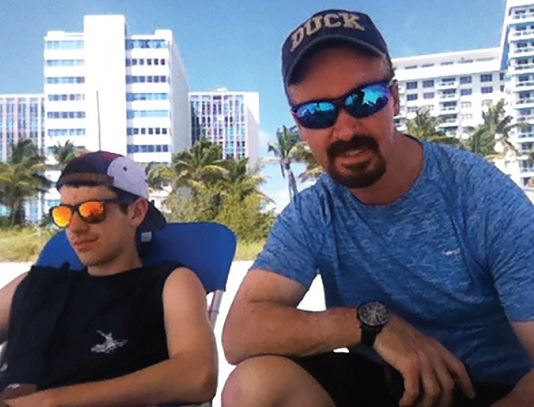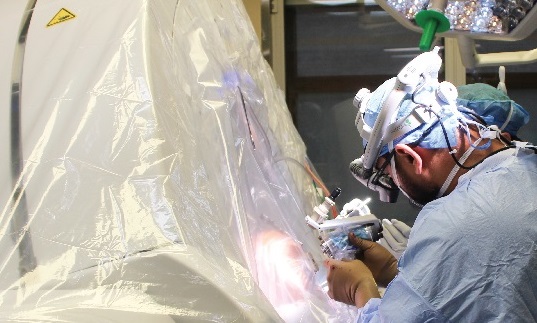“It was like turning on a light switch. Literally the next day, my voice was almost back to normal.”

A High-Tech Procedure Helps Control the Symptoms of Parkinson's Disease
In 2013, Mike McCormack of Wyckoff was diagnosed with Parkinson’s disease. Over the next five years, he struggled with the neurological disorder, which affects movement.
Even with medication, the father of three had tremors and numbness on his left side, which caused him to drag his foot. Occasionally, this resulted in tripping and falling. An avid outdoorsman, Mike had to stop hiking, skiing and participating in other activities. He also developed a stutter.
“I knew I had to do something,” recalls Mike, now 57. “I was maxed out on the medications and experiencing side effects. Quite frankly, I was something of a mess.”
Thankfully, Mike’s life began to turn around in April 2019 when he underwent a procedure known as deep brain stimulation (DBS) at Robert Wood Johnson University Hospital (RWJUH).
“The operation involves putting two wires into the brain, which are connected to a generator in the chest,” explains neurosurgeon Shabbar Danish, MD, Professor, Department of Neurosurgery, Rutgers Robert Wood Johnson Medical School and Director, Stereotactic and Functional Neurosurgery. “The wires are programmed to change how the circuitry in the brain works.”
 During the surgery, Mike was awake so that Dr. Danish could ask him to perform simple movements and ensure that the wires were being placed in the best spots to minimize his symptoms.
During the surgery, Mike was awake so that Dr. Danish could ask him to perform simple movements and ensure that the wires were being placed in the best spots to minimize his symptoms.
One week later, Mike had another surgery to implant the battery-powered generator, a pacemaker-like device, in his chest. A wire under the skin connects the generator to electrodes in the brain.
Robotics Expertise
DBS has been around for about 30 years, but Mike was one of the first patients at the hospital to undergo the procedure with the hospital’s new surgical robot. The robotic surgery has several advantages: patients aren’t required to have their head fixed in a cage during the procedure, and it requires a smaller opening in the dura, the covering of the brain.
“That usually means less air gets into the brain during surgery, and that hopefully means a faster recovery,” says Dr. Danish.
RWJUH is the only hospital in the Northeast and one of only a few in the country that uses the Mazor robotic system for DBS.
Mike’s symptoms started improving right away—particularly the stuttering.
“It was one of the first things I noticed when I got out of surgery,” he says. “It was like turning on a light switch. Literally the next day, my voice was almost back to normal.”
He’s walking much better, too.
“I occasionally have some numbness in my left foot,” he says. “But it’s not nearly as bad as it was before the surgery.”
Sometimes, Mike still experiences shaking in his left hand if he’s anxious, but he can stop it with a few deep breaths. “I don’t sit and shake,” he says.
Overall, Mike estimates his symptoms are about 75 percent improved. He’s taking much less medication now, too.
“I couldn’t be more pleased with the results,” he says. “I’m very happy with how things are progressing. It’s not a cure, and I wasn’t expecting a cure, but it’s been wonderful.”
Symptom Relief
Dr. Danish says DBS can offer relief to many Parkinson’s patients who have movement-related symptoms—such as tremors and rigidity—and aren’t being sufficiently helped by medications or are experiencing too many side effects.
“This operation gives people their lives back,” says Dr. Danish. “Most patients with Parkinson’s are living every day on the clock. They know exactly when to take their medications, when the medications kick in and when they wear off. This operation completely changes that. It removes the need for some of the medications and it eliminates patients’ symptoms in a steady fashion, meaning they aren’t fluctuating.”
DBS is also used to treat other health conditions, including epilepsy, essential tremor, dystonia (a disorder that results in repetitive or twisting movements) and obsessive-compulsive disorder.
After surgery, patients must periodically have their device programmed. This is to ensure that it’s working at the optimal level to minimize symptoms without causing any side effects from overstimulation, such as tingling, uncontrolled movements or visual or speech problems.
Today, Mike visits with nurse practitioner Deborah Caputo about every three months to determine whether his device needs any adjustments.
“Parkinson’s will continue to progress, so there are times we’ll need to tweak the settings,” she says. “There are times we may need to tweak Mike’s medications. But DBS does restore a person’s quality of life.”
Mike knows that firsthand. Happily, he has returned to his favorite pastimes.
“I’m back to activities I couldn’t do before,” he says. “I walk or hike with the dog almost every day. Come wintertime, I’ll hopefully be skiing.”
Learn more about Parkinson’s disease and treatment at Robert Wood Johnson University Hospital.